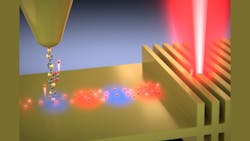High-energy or “hot” electrons have been of interest for some time in many fields because of their potential for accelerating electronic reactions. But to learn more about how to put hot electrons to work, researchers needed a practical measurement approach to measure the energy levels of those and other charge carriers. Fortunately, recent studies performed by scientists at the University of Michigan and Purdue University as part of the Department of Defense's (DoD’s) Multidisciplinary University Research Initiatives program and published in the journal Science provided details on the direct measurements of the energy levels and energy distributions of hot electrons.
The energy distribution of hot electrons was measured by a scanning tunneling microscope integrated with lasers and other optical components. Such measurements can provide insights on the efficiencies of different energy sources, such as motion-driven generators and solar panels. The research was funded by the Army Research Office (ARO), part of the U.S. Army Combat Capabilities Development Command’s Army Research Laboratory (ARL). Hot electrons can be generated by shining a certain type of light on metal nanostructures, typically composed of gold- or silver-based metals, to excite surface plasmons, producing energy for different applications as needed (see the figure). The research team created hot electrons by shining a laser onto a 13-nm-thick gold film with ridges designed to resonate at the frequency of the incident light.
“This multidisciplinary basic research effort sheds light on a unique way to measure the energy of charge carriers,” said Dr. Chakrapani Varanasi, an ARO program manager, who supported this study. “These results are expected to play a crucial role in developing future applications in energy conversion, photocatalysis and photodetectors, for instance, that are of great interest to the Department of Defense.” Dr. Edgar Meyhofer, a professor of mechanical engineering at University of Michigan, who co-led the research along with professors Pramod Sangi-Reddy and Vladimir Shalaev, explained: “If you wanted to employ light to split water into hydrogen and oxygen, you can use hot charge carriers because electrons that are more energetic can more readily participate in the reaction and drive the reaction faster.”
“Measuring energy distribution means quantifying how many electrons are available at a certain amount of energy,” said Harsha Reddy, a doctoral candidate in Purdue’s School of Electrical and Computer Engineering and co-lead author on this paper. “That crucial piece of information was lacking for expanding the use of hot electrons.”
About the Author
Jack Browne
Technical Contributor
Jack Browne, Technical Contributor, has worked in technical publishing for over 30 years. He managed the content and production of three technical journals while at the American Institute of Physics, including Medical Physics and the Journal of Vacuum Science & Technology. He has been a Publisher and Editor for Penton Media, started the firm’s Wireless Symposium & Exhibition trade show in 1993, and currently serves as Technical Contributor for that company's Microwaves & RF magazine. Browne, who holds a BS in Mathematics from City College of New York and BA degrees in English and Philosophy from Fordham University, is a member of the IEEE.
